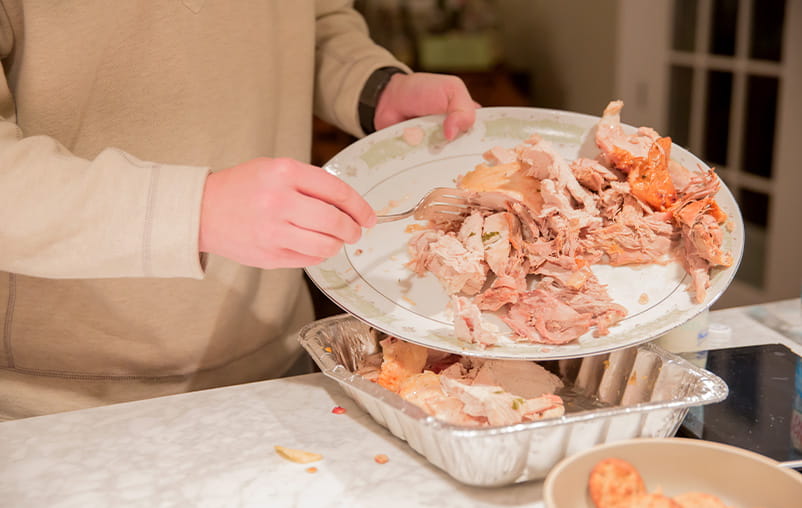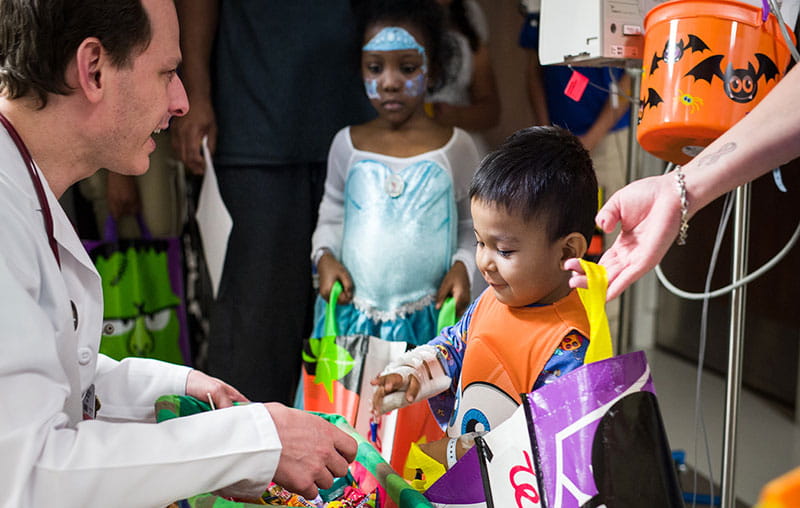Rex’s Burn Story
During lunch at school, 11-year-old Rex accidentally spilled ramen broth on his foot. The liquid was warm but not boiling.
Rex removed his shoe and sock to inspect his wet foot. When all looked normal, he put the shoe and sock back on his foot and continued eating lunch.
Twenty minutes later, he began to feel some pain. After another foot inspection, he noticed a burn was starting to appear. Five days later, Rex would have multiple surgeries on his foot for a deep, third-degree burn. To learn more about Rex’s story, watch his family’s interview on KSAT 12.
“Liquids and food particles that are hot can cause burns with continued exposure. In Rex’s case, the sock was warm and left in place for a prolonged period, causing continued exposure and burn to the foot,” said Dr. Christopher Crane, pediatric burn director with University Health’s Level I pediatric trauma and burn center. “Burns, even those that seem minor, should be treated quickly to avoid continued exposure.”
Learn more about burn prevention at home, myths and facts of treating minor burns and when to get medical attention for yourself or your child.
Understanding Burn Types & Treatment
You’ve probably heard you should put cold water on a burn. Or was it warm water? Doesn’t honey help soothe a burn, too? There are many misconceptions about the best ways to manage a minor burn at home. Learn how to treat minor burns at home and know when to go to the emergency room.
Superficial Burns (First-Degree)
Small superficial burns, like a sunburn or a burn from touching a hot pan, usually don’t need medical attention. They can usually be soothed with a cold compress and over-the-counter pain relievers like ibuprofen. Superficial burns only affect the outer layer of the skin and usually heal within two weeks. During this time of healing, superficial burns may develop blisters and require a health care provider assessment.
You can apply moisturizer or aloe vera to soothe your skin and prevent it from drying out.
Partial Thickness Burns (Second-Degree)
A partial thickness burn affects the outer and second layers of your skin, and blisters will be present. These are more severe than superficial burns but might still be treated at home depending on the size and location of the burn. Any burn over a joint should be seen by a health care provider.
Partial thickness burns may be caused by:
- Fire
- Electric shock
- Chemicals
- Hot objects
- Scalding from steam or boiling water
You can treat a partial thickness burn at home by:
- Running cool tap water over the skin for 10-20 minutes at a time
- Covering the burn with non-stick gauze or a clean bandage that you change daily
- Taking over-the-counter pain relievers
If blisters pop or drain, the loose skin may need to be removed by a health care provider.
Full Thickness Burns (Third- and Fourth-Degree)
A full thickness burn affects all three layers of the skin and requires emergency medical care. The skin may appear dry, leathery, swollen and may change color to black, white, brown or yellow.
Depending on the severity of the burn, treatment may include:
- IV fluids containing electrolytes
- Breathing and blood circulation support
- Oral antibiotics
- Antibiotic cream (bacitracin or Neosporin)
- Removing dead tissue from the area
- Skin grafts
- Surgery
- Special bandages
- Follow-up care including physical and occupational therapy
How to Treat a Burn
Depending on the size of the burn, most first-degree and some second-degree burns may be treated at home. Here are the six steps you will want to take:
- Cool the burn under cool running tap water for about 10-20 minutes or until the pain goes away. Make sure the water is cool, not cold.
- Once you dry the burned area, apply petroleum jelly or a fragrance-free, alcohol-free moisturizer. You will want to repeat this step throughout the day.
- Cover the burned area loosely with a bandage. This will protect the area from getting infected, especially if you are blistering.
- If your burn causes blisters, do not pop them. If the blisters break on their own, clean the area and apply antibiotic ointment. Depending on the size of the broken skin, this may need to be removed by a health care provider for better healing.
- Take over-the-counter pain medications like acetaminophen or ibuprofen if you are feeling pain.
- Limit your time in the sun to avoid direct sunlight on your burn. If you go outside, keep the burned area covered with clothing or a bandage.
Following these steps will help ensure that your burned area will heal appropriately and not worsen.
What Not to Put on a Burn
Applying condiments or items found around the kitchen can lead to infection. Do not put the following on a burn:
- Butter
- Grease
- Ice
- Oil
- Toothpaste
- Honey
- Mustard
Instead, you can use petroleum jelly or a cool compress (not ice), and be sure to wrap the compress in a thin towel, not directly onto your skin.
When a Burn Is Infected
If a minor burn becomes infected, you should seek medical attention. Signs of an infected burn may be:
- Redness around the burn site
- Low grade fever
- Skin discoloration
- Pus leakage
- Bad odor coming from the burn site
- Severe pain
- Swelling
Your provider can prescribe antibiotics to resolve the infection.
When to Seek Medical Attention
If there is any concern whatsoever, seek medical care. You should always seek medical attention for partial thickness burns and large deep partial thickness burns.
Partial thickness burns that are more extensive or involve joints, face, genital areas, hands and feet need medical attention to ensure healing.
You may also need physical or occupational therapy to ensure the scarring is minimized and the joints retain normal function.
Burn Prevention
The easiest way to treat a burn is to prevent it from happening. Some tips to prevent burns at home include:
- Check water heater setting to ensure it does not exceed 120 degrees Fahrenheit
- Test bath water before using
- Always direct pot handles toward the center or back of the stove
- Do not cook or have active heat sources on the ground
- Ensure lighters are out of reach
- Never allow children to handle hot liquids
- Keep coffee or hot liquids out of reach
- Thoroughly rinse fire pits when not in use
- Keep curling irons and straighteners out of reach
- Do not set pots/containers with hot liquid on the floor
- Do not transport pots/containers of hot liquids in a vehicle
- Do not allow play in areas with ashes
- Do not throw igniting fluids onto open flames
- Wear appropriate footwear outside on hot summer days
- Supervise children when they use a microwave
- Keep cords for cooking instruments (slow cooker, electric kettles, etc.) out of reach of children
- Do not set children on counter tops with active heat source near by
Burn Care at University Health
Learn more about burn prevention and the pediatric burn program at University Health in San Antonio.





